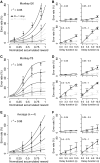Measuring and modeling the interaction among reward size, delay to reward, and satiation level on motivation in monkeys
- PMID: 18987119
- PMCID: PMC2637024
- DOI: 10.1152/jn.90959.2008
Measuring and modeling the interaction among reward size, delay to reward, and satiation level on motivation in monkeys
Abstract
Motivation is usually inferred from the likelihood or the intensity with which behavior is carried out. It is sensitive to external factors (e.g., the identity, amount, and timing of a rewarding outcome) and internal factors (e.g., hunger or thirst). We trained macaque monkeys to perform a nonchoice instrumental task (a sequential red-green color discrimination) while manipulating two external factors: reward size and delay-to-reward. We also inferred the state of one internal factor, level of satiation, by monitoring the accumulated reward. A visual cue indicated the forthcoming reward size and delay-to-reward in each trial. The fraction of trials completed correctly by the monkeys increased linearly with reward size and was hyperbolically discounted by delay-to-reward duration, relations that are similar to those found in free operant and choice tasks. The fraction of correct trials also decreased progressively as a function of the satiation level. Similar (albeit noiser) relations were obtained for reaction times. The combined effect of reward size, delay-to-reward, and satiation level on the proportion of correct trials is well described as a multiplication of the effects of the single factors when each factor is examined alone. These results provide a quantitative account of the interaction of external and internal factors on instrumental behavior, and allow us to extend the concept of subjective value of a rewarding outcome, usually confined to external factors, to account also for slow changes in the internal drive of the subject.
Figures







References
-
- Bowman EM, Aigner TG, Richmond BJ. Neural signals in the monkey ventral striatum related to motivation for juice and cocaine rewards. J Neurophysiol 75: 1061–1073, 1996. - PubMed
-
- Chudasama Y, Wright KS, Murray EA. Hippocampal lesions in rhesus monkeys disrupt emotional responses but not reinforcer devaluation effects. Biol Psychiatry 63: 1084–1091, 2008. - PubMed
-
- Critchley HD, Rolls ET. Hunger and satiety modify the responses of olfactory and visual neurons in the primate orbitofrontal cortex. J Neurophysiol 75: 1673–1686, 1996. - PubMed
-
- Cromwell HC, Schultz W. Effects of expectations for different reward magnitudes on neuronal activity in primate striatum. J Neurophysiol 89: 2823–2838, 2003. - PubMed
-
- Gibbs J, Maddison SP, Rolls ET. Satiety role of the small intestine examined in sham-feeding rhesus monkeys. J Comp Physiol Psychol 95: 1003–1015, 1981. - PubMed
Publication types
MeSH terms
Grants and funding
LinkOut - more resources
Full Text Sources
Other Literature Sources

